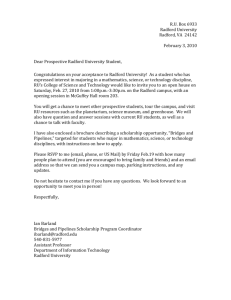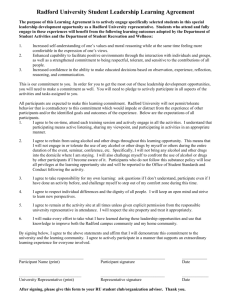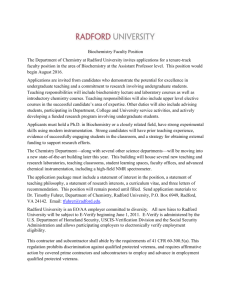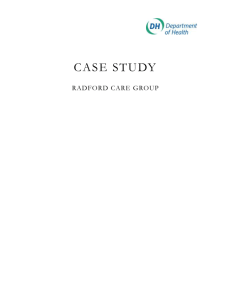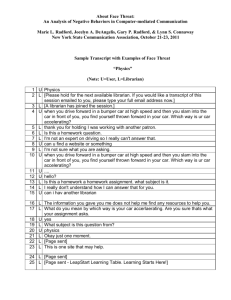File - Marlina Fraterman, MLIS
advertisement
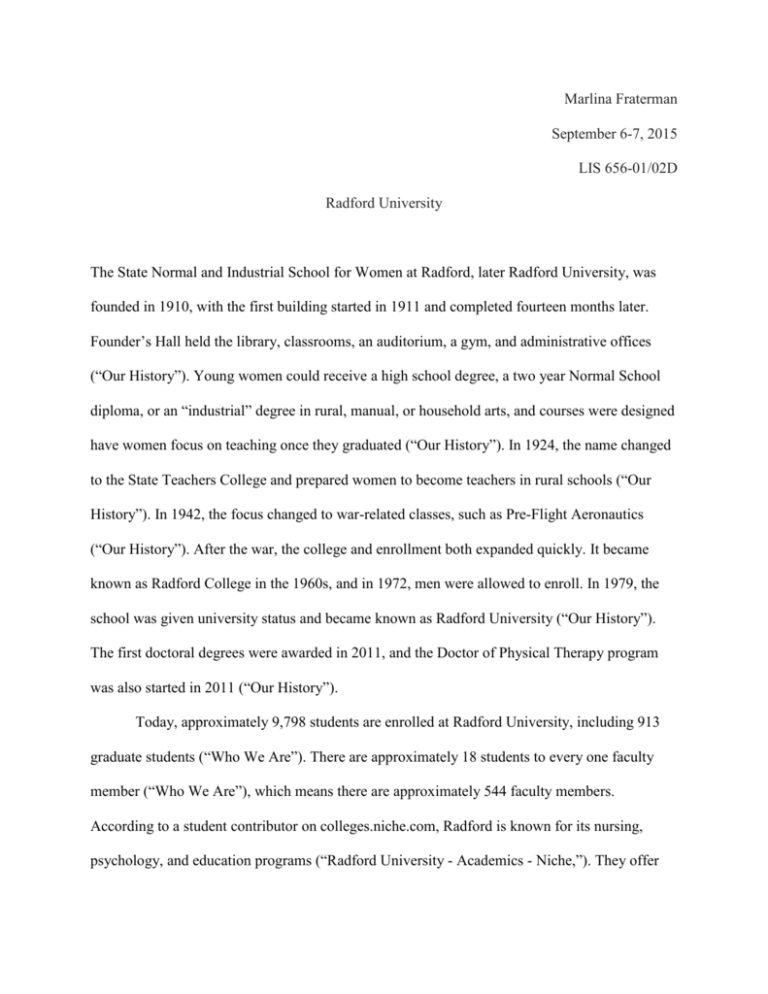
Marlina Fraterman September 6-7, 2015 LIS 656-01/02D Radford University The State Normal and Industrial School for Women at Radford, later Radford University, was founded in 1910, with the first building started in 1911 and completed fourteen months later. Founder’s Hall held the library, classrooms, an auditorium, a gym, and administrative offices (“Our History”). Young women could receive a high school degree, a two year Normal School diploma, or an “industrial” degree in rural, manual, or household arts, and courses were designed have women focus on teaching once they graduated (“Our History”). In 1924, the name changed to the State Teachers College and prepared women to become teachers in rural schools (“Our History”). In 1942, the focus changed to war-related classes, such as Pre-Flight Aeronautics (“Our History”). After the war, the college and enrollment both expanded quickly. It became known as Radford College in the 1960s, and in 1972, men were allowed to enroll. In 1979, the school was given university status and became known as Radford University (“Our History”). The first doctoral degrees were awarded in 2011, and the Doctor of Physical Therapy program was also started in 2011 (“Our History”). Today, approximately 9,798 students are enrolled at Radford University, including 913 graduate students (“Who We Are”). There are approximately 18 students to every one faculty member (“Who We Are”), which means there are approximately 544 faculty members. According to a student contributor on colleges.niche.com, Radford is known for its nursing, psychology, and education programs (“Radford University - Academics - Niche,”). They offer “67 degree programs in 38 disciplines and two certificates at the undergraduate level; 22 master’s programs in 17 disciplines and three doctoral programs at the graduate level; 10 postbaccalaureate certificates and one post-master’s certificates” (“Facts and Figures”). The top five majors in Radford are Pre-Major; Interdisciplinary Studies- Elementary Education; Exercise, Sport, and Health Education; Pre-Business; and Criminal Justice (“Academic Programs”). They have a College of Business and Economics, with majors in Economics, Management, Marketing, and Accounting, Finance, and Business Law, as well as other related majors. There is a College of Education and Human Development; some of the majors are Appalachian Studies, Counselor Education, Nutrition and Dietetics, and Recreation, Parks, and Tourism. The Waldron College of Health and Human Services offers a number of programs, such as Occupational Therapy, Social Work, and the School of Nursing. There is also a College of Humanities and Behavioral Sciences that includes the School of Communication, English, History, Liberal Arts Philosophy and Religious Studies, and Sociology, among others. The College of Science and Technology offers Biology, Geospatial Science, Informational Technology, and Chemistry, as well as others. Finally, the College of Visual and Performing Arts offers Art, Dance, Design, Music, and Theatre and Cinema (“Colleges & Academic Departments”). Their graduate degrees are offered in majors such as Art, Speech and Language Pathology, Criminal Justice, Nursing Practice, Education, English, Music, and Special Education, among others (“Programs and Degrees”). There are a multitude of other majors for both undergraduates and graduates, as well, though. The Doctor of Physical Therapy is a special program because it “address[es] a critical need for physical therapists in Southwest and Southside Virginia (“Our History”). One unusual but interesting thing that Radford University is known for is Quadfest. Started by the school in 1996 and held two weeks before the final spring exams, Quadfest was a music festival sponsored by several campus organizations. It quickly became the biggest offcampus party weekend, and in 2006, it was no longer a school sponsored event. However, students have kept it thriving as an unofficial, student-led event (“Quadfest”). Radford University’s sports teams are known as the Highlanders. There are sixteen sports in the Division I program, and they compete in the Big South Conference (“Facts and Figures”). Radford University “is accredited by the Commission on Colleges of the Southern Association of Colleges and Schools to award baccalaureate, masters, educational specialist and doctorate degrees” (“Who We Are”). Their SAC classification would be a level V: “offers three or fewer doctorate degrees as highest degrees” (“Commissions on Colleges”). Their Carnegie Classification is as follows: Undergraduate Instructional Bal/SGC: Balanced arts & sciences/professions, some graduate Program: coexistence Graduate Instructional Postbac-A&S/Ed: Postbaccalaureate with arts & sciences Program: (education dominant) Enrollment Profile: VHU: Very high undergraduate Undergraduate Profile: FT4/S/HTI: Full-time four-year, selective, higher transfer-in Size and Setting: M4/R: Medium four-year, primarily residential Basic Master's L: Master's Colleges and Universities (larger programs) (“Carnegie Classifications | Institution Profile -Radford University”). Switching gears, the library on campus is McConnell Library. McConnell Library was opened in 1932 and named after the university’s first president, Dr. John Preson McConnell. According to the staff member I spoke with, “[t]here are many stories about him finding ways to allow needy girls to enroll in college and figure out payment later,” so naming the library after him was fitting. Before McConnell Library was built, the library was housed in Founder’s Hall, which is now the administrative building (Fraterman & Johnson, 2015). The original library was two floors—one floor was study tables and a circulation desk and one floor was the stacks. There was an expansion in the 1960s that added two floors with no windows. Another addition in the 1990s added a fifth floor with windows (Fraterman & Johnson, 2015). The staff member stated that recently “we have weeded out large numbers of books and turned that space into study areas. I think this is our future… More space for students to BE, and less space devoted to physical books” (Fraterman & Johnson, 2015). Ms. Johnson, the staff member, stated that they have a “flat” library structure (Fraterman & Johnson, 2015). According to her there is one Dean and one Administrative Assistant, a department head for each of their six areas, and that many of the staff perform multiple jobs. The faculty has rank but not tenure and participates in the Faculty Senate, the Administrative/Professional Faculty Senate, and many are active in the campus Staff Senate (Fraterman & Johnson, 2015). The six areas in the library are Archives and Special Collections, Access Services, Reference, Instruction, Library Technology, and Collection and Tech Services (Fraterman & Johnson, 2015). There are thirty-four staff members (“Staff Directory”). In addition to them, though, there are seven or eight graduate students, up to fifty undergrad assistants, a couple of interns, and a couple of special needs students (Fraterman & Johnson, 2015). Ms. Johnson wrote that they have approximately 500,000 physical books at McConnell Library, but they just had a weeding project and is unsure of the new figure. She also did not know the number of journals, partly because of VIVA—the Virtual Library of Virginia—which provides members with a large variety of resources they could not afford otherwise (Fraterman & Johnson, 2015). However, she sent a spreadsheet from another staff member that said there were 257,540 books and 288,716 volumes. It is a little unclear if “volumes” means number of copies total or Journals in this case (Fraterman & Johnson, 2015). There are 370 databases available at McConnell Library (“A-Z Databases - LibGuides at Radford University”). McConnell Library and Radford University seem like interesting places. They have a rich history and have made it through numerous hardships, such as the Great Depression and WWII (although McConnell Library was not built yet). It is amazing how such a small school can survive and thrive as Radford University has done. References Academic Programs | Radford University. (n.d.). Retrieved September 7, 2015, from http://www.radford.edu/content/radfordcore/home/academics.html A-Z Databases - LibGuides at Radford University. (n.d.). Retrieved September 6, 2015, from http://libguides.radford.edu/az.php? Carnegie Classifications | Institution Profile -Radford University. (n.d.). Retrieved September 6, 2015, from http://carnegieclassifications.iu.edu/lookup_listings/view_institution.php?unit_id=233277 Colleges & Academic Departments | Radford University. (n.d.). Retrieved September 7, 2015, from http://www.radford.edu/content/radfordcore/home/academics/colleges-and-departments.html Commission on Colleges. (n.d.). Retrieved September 6, 2015, from http://www.sacscoc.org/details.asp?instid=58800 Facts and Figures | University Relations | Radford University. (n.d.). Retrieved September 7, 2015, from http://www.radford.edu/content/university-relations/home/facts-and-figures.html Fraterman, M., & Johnson, E. (2015, September 6). Request for Help. Our History. (n.d.). Retrieved September 7, 2015, from http://www.radford.edu/content/radfordcore/home.html Programs and Degrees | College of Graduate Studies and Research | Radford University. (n.d.). Retrieved September 6, 2015, from http://www.radford.edu/content/grad/home/academics/programs-degrees.html Quadfest - Wikipedia, the free encyclopedia. (n.d.). Retrieved September 6, 2015, from https://en.wikipedia.org/wiki/Quadfest Radford University - Academics - Niche. (n.d.). Retrieved September 7, 2015, from https://colleges.niche.com/radford-university/academics/ Staff Directory. (n.d.). Retrieved September 6, 2015, from http://library.radford.edu/index.php/Generated/StaffDirectory Who We Are | Radford University. (n.d.). Retrieved September 7, 2015, from http://www.radford.edu/content/radfordcore/home/about.html
